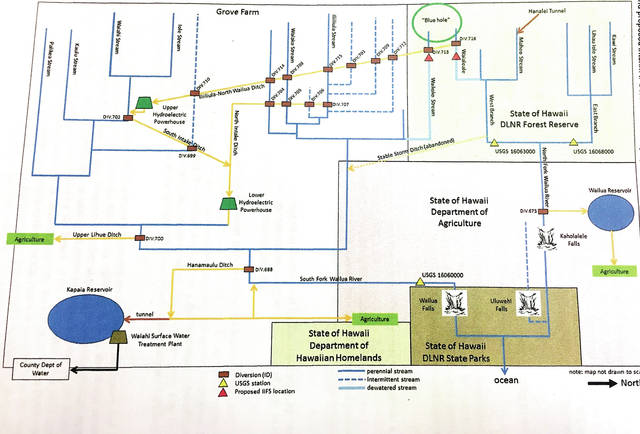WAILUA — Kauai Island Utility Cooperative uses a system of century-old diversions in Kauai streams to supply water to two hydroelectric facilities in the Wailua watershed.
KIUC is returning water to the Wailua and Waikoko streams below the diversions; but some community members say what they’re doing isn’t quite what the law requires.
A meeting hosted by the Wailua-Kapaa Neighborhood Association on Saturday at the Kapaa Public Library will bring citizens face to face with David Bissell, KIUC’s president and chief executive officer.
“This meeting is a valuable opportunity to understand KIUC’s position and to assess whether these public trust waters are being used equitably,” said W-KNA chairperson Rayne Regush.
The debate swirls around two main points — stream rewatering and a long-term lease that includes environmental impact analysis.
KIUC holds a short-term revocable permit for use of those diversions, one that the state Board of Land and Natural Resources has been renewing since KIUC secured the permit in 2003.
When the permit was last renewed in December, the BLNR ruled KIUC must leave a base flow in Waikoko and Wailua Streams to restore mauka to makai flow. The board ruled the Waikoko Stream must have a minimum of 1.4 million gallons per day base flow, and Wailua Stream must have four million gallons per day.
Those numbers were distilled from Interim Instream Flow Standards, set by the state Commission on Water Resources Management, and representatives of KIUC say those requirements have been met.
“KIUC has reduced our diversion amount at North Fork and Waikoko to be consistent with the CWRM staff IIFS recommendation,” said Beth Tokioka, KIUC spokeswoman. “So, there is always water in the stream downstream of the diversion.”
The W-KNA, however, said in a press release they don’t think that satisfies the law and still results in impacts to the ecosystem.
“Rewatering below the dam does not fulfill this permit condition,” the release said.
The other concern is that KIUC isn’t moving fast enough to secure the long-term water lease and dragging its feet on creating an Environmental Impact Study on the diversions.
“You have to complete an EIS to know how the ecosystem is being impacted,” said Bridget Hammerquist in a phone interview about the diversions. “These steps need to be followed.”
KIUC applied for the long-term lease in 2004 and has been working through the process of securing that lease for nearly 15 years. Representatives of the entity say it’s been a lengthy process that has required working with multiple agencies. They said they’re moving forward on environmental assessment.
“Statements are being made that KIUC is not planning to commence environmental studies until after receiving the lease and that is completely false,” Tokioka said. “We have been very open about environmental and cultural studies that have been completed and others that are still ongoing, which will be incorporated into an environmental disclosure document as a prerequisite for our final lease submittal to BLNR.”
A bill moving through the Hawaii Legislature, HB 1326, has thrown a few potential changes into the process and the final bill could impact KIUC’s timeline, but Tokioka said the goal is to submit the final lease application to BLNR by the end of 2019.
HB 1326 seeks to expand the temporary water diversion permits. Supporters say it could speed up the process to land a water lease and opponents say it creates a loophole for requirements like doing environmental assessment.
All of that will be on the table at the Kapaa Neighborhood Association on Saturday as experts and citizens engage in the diversion debate. That meeting is set to begin at 2 p.m. and is free to attend.
••• Jessica Else, environment reporter, can be reached at 245-0452 or at jelse@thegardenisland.com



…and you wonder why electricity rates are so high?
RG DeSoto